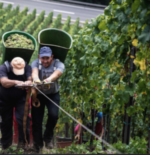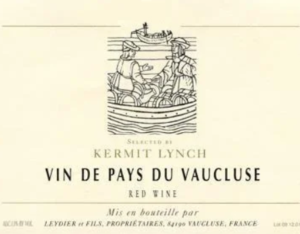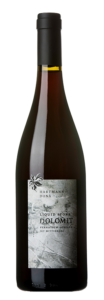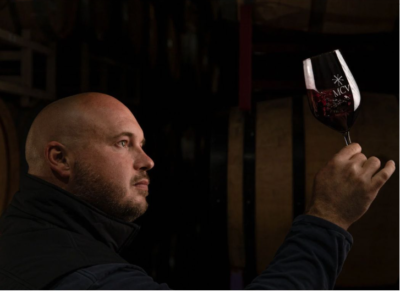CASE CLUB SELECTIONS – October, 2023
- Kermit Lynch Vaucluse Red (FR)
- Hartmann-Dona Schiava “Liquid Stone” (IT)
- Omen Zinfandel, (CA)
- Remy Saves the Sea Rose (CA)
- Elk Cove Pinot Gris (OR)
- Talai Berri Txakolina Finca Jakue Blanco (IT)
- Giacomelli Pianacce Vermentino (IT)
- MCV Petite Sirah, Paso Robles (CA)
- Caittin Steinbacch Pinot Noir (FR)
- Fibbiano Ciliegiolo, Tuscany (IT)
- Dr Loosen Urziger Wurzgarten Kabinett Riesling (GD)
- Secondo Marco Valpolicella (IT)
Kermit Lynch Vin de Pays du Vaucluse Red Wine (FR) $16
The Wine
There is a very high pleasure/dollar ratio here. I daresay you’ll find it difficult to believe the price once you taste the wine. Buying a case to stash away for emergencies (like “hey, it’s Wednesday!”) is a decision made by many wise wine lovers before you read this idea here.
Kermit Lynch is on the short list of our long-time favorite importers. And for many years he’s worked with the Leydier family, the owners of Domaine de Durban. This wine is sourced from vineyards of and around this Domaine, but the story of how this came to be is a classic. The vineyards were traditionally used for the Leydier family’s personal consumption or else simply sold off in bulk. And because the wines from this vineyard were never destined for commercial bottling, the family made no effort to have these parcels included in the A.O.C. Côtes du Rhône when the boundaries were first established in 1937.
Upon hearing the family had been selling these grapes to the local cave cooperative in Vacqueyras, Kermit presented the Leydiers the idea of creating a value-driven second label to Domaine de Durban. A collaboratoin was formed and together, they now bottle both a Vin de Pays de Vaucluse Rouge and Blanc.
Kermit, (very) Briefly
In 1972, with a $5,000 loan and no shortage of gumption, this writer/musician opened Kermit Lynch Wine Merchant in Berkeley, CA. His opening inventory of 35 cases of wine were stacked simply on the floor (a merchandising approach he still embraces).
Attracted by the Old World wine cultures of Europe, Kermit (Right) became an advocate for authentic wines that express their terroir. His influence has been enduring, to say the least. He has led the way for many other boutique importers who discover small, artisan producers winning two James Beard awards along the way. He sets a high bar for all who follow in his footsteps.
Hartmann-Dona Schiava “Liquid Stone”, Dolomit (IT) $21
The Winemaker

Hartmann family at play
In his own words, Hartmann’s insight seems familiar to many home gardeners who have discovered “my strength lies in understanding three factors – soil, vines, and weather – and in interpreting and working with them.” That is how original and unique products are created. It is in the differences from one year to the next that create the exclusive characteristic of nature’s authentic products.
The main characteristics – the house style – of his Donà wines are elegance, harmony, alpine freshness and minerality. They express a remarkable capacity for aging and can be extraordinarily long-lived for those who have the self-control not to separate them from their corks at a young age.
The winery is a family affair, with the couple and their three kids each contrbuting to the enterprise.
The Wine
Hartmann’s Liquid Stone series consists of four wines that showcase the Schiava grape grown in four different terroirs and soil types. This particular wine bears the DOLOMIT label and contains he fermented jusice of Schiava grown on 40-year-old vines from the south of the Sud Tyrol. This vineyard is one of the warmest in the Liquid Stone line (next to Phyllit, Granit and Vulkanit). Each of these is a different expression of the same grape (Schiava) on different soil types.
This vineyard faces southeast from its perch 1,000 feet above sea level. The soil is chalky, loamy and stony forcing the roots of the old vines to push deeper and deeper into the earth, and yet still they can only provide enough sustenance to support a sluggish growth that yields small Schiava grapes with high sugar, tannins and lower acidity. This is a wine that showcases the warm and robust side of the Schiava.
The fully ripe grapes ferment in wooden vats. Afterwards, the young wine continues to age in wooden barrels for 9 months. The result? A spicy wine that shows full ripeness and a velvety texture!
Omen Zinfandel “Origin”, Sierra Foothills (CA) $19
 The Wine
The Wine
Any tasting note for this wine focuses on its relatively low alcohol (13 – 13.5%), which allows its fruity perfume to shine unencumbered by heavy extraction, alcohol or oak. Medium-bodied offers complex aromas featuing hints of cedar, the tell-tale Zin notes of ripe blackberry, plum and a high note of raspberry. Armoatics finish with sweet pie spices – clove, cedar, cardamom and cinnamon – that beg for this wine to be paired with food!
The Winemaker

Omen is one of two brands from Atlas Wine Co, created to seek out hidden gem wine appellations throughout the West coast.
As his Bio goes, French-born Alexadre Remy left the world of Luxe producers in France (Rothschild, Moet & Chandon) and many other global wine regions. Whether he was burned out or simply seeking to shed his varoius lieges, he found refuge with his own Atlas Wine co, a start-up located in California’s up-and-coming Sierra Foothills. They can be found in the town of Fairplay, a whimsical name which seems almost portentious here, almost like an omen. See what I did there?
It is here he has joined other Napa notables such as Marco Capelli (formerly of Swanson), Helen Kiplinger and Andy Ericson (the man behind the Casino Mine Greco we featured previously) as they pursue new challenges outside the confines of Napa.
His guiding principles include wines made with low sulfites (<75 PPM, for those counting), no toxic additives, Vegan/Paleo/Keto-friendly, without residual sugar – just as with most of the wines we carry. But his wines are, somehow, remarkably, priced under $20. No surprise they’ve come to be known for their impressive value.
‘Remy Saves the Sea’ Sonoma Rosé (CA) $18.50
 This is an entirely different Remy than the one profiled above. In this case, Remy is a young woman of some 13 years. And she’s a surfer who learned to love the sport with her Dad, Noah. No seriously, that’s his name. And no, he doesn’t own an ark. Let’s get back to our story, shalllll we?
This is an entirely different Remy than the one profiled above. In this case, Remy is a young woman of some 13 years. And she’s a surfer who learned to love the sport with her Dad, Noah. No seriously, that’s his name. And no, he doesn’t own an ark. Let’s get back to our story, shalllll we?
Remy grew increasingly concerned about the state of our oceans and beaches. Micro plastics. Oil. Dying species. The whole bit. So what’s a young sea-loving person to do?

Well if your father is Noah Dorrance, who took a small fortune from the sale of Banshee wines, then started his own winery named after his son, Reeve, if THAT guy is your dad,
you convince him to create a Rose wine that sends a portion of proceeds to save the sea, hence the name. And that’s exactly what Remy did. Label art and all. And it’s been our best-selling rosé all summer long.
If ever there was a wine to convince rosé-lovers that the wine can be a year-round pleasure, this is it.
Did you know?
Did you know that about 17.6 billion pounds of plastic—or the equivalent of nearly 57,000 blue whales—is dumped in the ocean every single year. By 2050, ocean plastic will outweigh all of the ocean’s fish.
Elk Cove Estate Pinot Gris (OR) $20
The Winery
 Do you remember what you were doing in 1974? I remember it as the year Nixon resigned – I was a high school student working that summer on a furniture loading dock when the news came over the radio. I knew it was historic.
Do you remember what you were doing in 1974? I remember it as the year Nixon resigned – I was a high school student working that summer on a furniture loading dock when the news came over the radio. I knew it was historic.
 But if you were Pat and Joe Campbell, an ER physician from a family of farmers, you’d be making your own history. As Tricky Dick was waving goodbye as he boarded Air Force One, the Campbells were pulling a small camper trailer, the family home for the next year, up to your ‘new’ property in the hills of Oregon. The abandoned orchards were overgrown and had little water, so the Campbells looked for a crop that could survive in low water conditions. To make a long story short, wine grapes were planted, wine was made, and the Campbells named their farm “Elk Cove Vineyards” after a herd of elk that once settled in around their trailer for the night.
But if you were Pat and Joe Campbell, an ER physician from a family of farmers, you’d be making your own history. As Tricky Dick was waving goodbye as he boarded Air Force One, the Campbells were pulling a small camper trailer, the family home for the next year, up to your ‘new’ property in the hills of Oregon. The abandoned orchards were overgrown and had little water, so the Campbells looked for a crop that could survive in low water conditions. To make a long story short, wine grapes were planted, wine was made, and the Campbells named their farm “Elk Cove Vineyards” after a herd of elk that once settled in around their trailer for the night.
 Elk Cove became Oregon’s 10th licensed winemaking facility, located in what would someday be the famed Yamhill-Carlton wine region. In short order their wines were winning awards, and that was the beginning of what would become an impressive business. Today their son, Adam, is at the helm, managing six vineyards with 380 planted acres – over ten times the size of his family’s original planting. Oregon now boasts more than 700 wineries, but Elk Cove was there from the early days (photo, left – the 10th winery must have doubled as photographer!). They remain one of the last of the early pioneers to be family-owned and operated.
Elk Cove became Oregon’s 10th licensed winemaking facility, located in what would someday be the famed Yamhill-Carlton wine region. In short order their wines were winning awards, and that was the beginning of what would become an impressive business. Today their son, Adam, is at the helm, managing six vineyards with 380 planted acres – over ten times the size of his family’s original planting. Oregon now boasts more than 700 wineries, but Elk Cove was there from the early days (photo, left – the 10th winery must have doubled as photographer!). They remain one of the last of the early pioneers to be family-owned and operated.
The Wine
When it comes to white wines, Oregon is known for its Chardonnay. But to me it’s their Pinot Gris that is the standout – great wine, food-friendly, and a true bargain even on the world stage, which is rare for a domestic wine! In this incarnation, the wine offers aromas and flavors dominated by stone fruits, candied ginger and peach. Would be a perfect match for one of my favorite Italian dishs – a simple slice of perfectly-ripened melon, wrapped in prosciutto. We don’t sell melons, but you can get everything else in either of our shops!
Talai Berri Finca Jakue White Txakoli (ES) $19.50
The Winery
As a man who spends his days helping customers discover new favorites from obscure corners of the wine world, it does my heart good to see the rise in popularity of wonderful but obscure varietals. The Txaolina (chock-oh-LEE-nah) wines join the ranks of other once-obscure wines that have enjoyed recent surges in popularity among curious wine lovers – dry roses, Gruner Veltliner, Vinho Verdes, Assyrtiko, those from volcanic soils, and several others I’m forgetting.
The Basque wine country is found just West of the Pyranees, where France and Spain’s shared border ends. Since the dawn of humankind, this region has been a prolific source of Atlantic seafood and Ports of call. This particular wine comes from Getariako, one of three Txakolina appellations, that takes its name from the sea-side town of Getaria (right). Known for its gastronomy, the town benefits from fishing boats that provide daily fish supplies to the many area restaurants. And the wine they serve? Txakolina is everywhere!
Though the winery, Talai Berri, is unknown to many outside the Basque region, they are a local legend. Back in 1992, they became the first winery to be built from the ground up to satisfy all the requirements of the new “Txakoli de Getaria Guarantee of Origin (1989)”. Though the Eizaguirre family had produced wine for generations, the new requirements made for a frustrating and protracted compliance effort until owner Bixente Eizaguirre decided to chuck it all and build a new, fully-compliant winery.
The Wine
The grape used here is as much fun to say as it is to drink – the Honndurabi Zuri. But it’s DNA tests indicate an uncertain lineage that leaves us scratching our heads. It might actually consist of three different, even more obscure grapes, but let’s not let that unsolved mystery interfere with our enjoyment here. Note – there are also red and rose versions of Txakolina, made from a grape called Hondarribi Belza, but they are destined for even more localized consumptoin and rarely find their way to domestic wine shelves. If you see one, buy it, as they are worth tasting.
Reach for this bottle when you need a white wine with a slightest suggestion of fizz, a subtlelty that makes it refreshingly lift off the palate more than appear spritzy. The aromas hint at lychee nut, if you’ve ever been curious enough to buy one at the Asian food store. If not, know that it is both fruity and slightly nutty/medicinal – is that a hint of iodine I’m getting? (sniffs glass from other nostril, as if that will help, but all it does is look pretentious). Extended period of lees stirring has left this wine with an unctuous, mouth-filling richness. It’s middle-weight body seeks dishes with a similar constitution. Think Asian food, paella, Fall salads with sliced persimmon, and most richer versions of fish and definitely with roast poultry.
Giacomelli Vermentino Colli di Luni Pianacce (IT) $27
 The Wine
The Wine
Vermentino is THE white wine of Liguria, and it’s best-known product, other than Carrara marble. This sea-side town enjoys the bounty of the sea and its wines are perfect compliments to the local dishes. Try to find the regional favorite ‘Testaroli’, if you can, dumplings with a simple pesto. Testaroli and a bottle of Vermentino are heaven.
Vermentino from Colli di Luni are less herbaceous than the rest of Liguria, as it is a warmer region. But they are in between the typical Ligurian Vermentino and the richer versions from Sardigna. Pour some of this wine into your glass and smell the aromas of fresh herbs like basil and sage complimenting citrus notes, all followed by a finish that hints at an almond-like bitterness.
The Winery
 Liguria is one of the smallest of Italy’s 21 wine regions. You’ll find it tucked in just south of Piemonte and West of Northern Tuscany.
Liguria is one of the smallest of Italy’s 21 wine regions. You’ll find it tucked in just south of Piemonte and West of Northern Tuscany.
And the Colli di Luni (hill of the moon) is located in the lower-right portion of Liguria. This tiny region is home to a scant 62 acres of vines. The region’s name is a bit of a mystery, as it

dates back to Roman times and is not well documented (Pliney the Elder, where are you when we need you?!). But it seems reasonable to suspect it may be named for the famous white-marble cliffs, qarried for centuries to get access to its prestine Carrara marble (right).
The Giacomelli winery is the brain child of one very determined man, Roberto Petacchi (left), who converted his family farm to pursue the perfection of Vermentino. Thiry years and many awards later, his dream has proven rewarding, both financially and with the repsect of his peers.
MCV Petite Sirah, Paso Rolbes (CA) $39
 The Wine
The Wine
This is classic Petite Sirah, rendered in a purely California style. That is to say, if you’re wearing socks, prepare to have them knocked off. This is not a wine for the feint of heart. Weighing in at 14.9% ABV, and made from 100% Petite Sirah from three vineyards MCV has been working with for years – Derby Estate, Gemeny and Parrish Family. But if there was ever a wine with shoulders broad enough to handle high alcohol, it would be Petite Sirah.
Known as a wine that can age for decades, I sometimes suggest buying a bottle in the birth year of a newborn so it can be gifted to them on their 21st birthday.
A quick note on the grape – there is nothing small about ‘petite’ Sirah. The flavors are big, the grape clusters are big, and the tannins are big! The term ‘petite’ refers to the size of the individual berries. Because they are small, there is a higher ratio of skin to meat (pulp), resulting in the tannic structure that helps this wine age.
Aromas of blueberry, wet stones, dark chocolate, beef jerky and mocha. On the palate the wine offers the same profile as the aromas, with perhaps some addition of freshly gournd white peppercorns.
The Winery
A family-run winery that launched in 2011, MCV specializes in Petite Sirah. They still work with some of the vineyards that helped launch the enterprise 12 years ago.
Joseph Cattin Steinbach Pinot Noir, Alsace (FR) $28
 About the Wine
About the Wine
This rich and full-bodied Pinot (which will be hugely popular with fans of New World Pinots) is produced in the far south of Alsace. It takes its name from the village of STEINBACH, which has been long renowned for its high-quality Pinots.
These wines were once called “STEINBACHER RODA,” meaning the “Red from Steinbach”, which everyone just knew to be Pinot Noir. This wine is surprisingly age-worthy, and is just now hitting its prime, where we anticipate it will remain for the next few years before beginning a slow descent sometime late in the decade. Limited yields from vines planted on the south-east facing slopes on Ferruginous sandstone soils.
About the Winery
Cattin is the largest family-owned and family-operated winery in Alsace. It is located in Voegtlinshoffen, a small village on the foothills of the Vosges Mountains at 1,091 feet in elevation. The Cattin family has been producing wine here since 1720 and today the winery is managed by the 12th generation. Those old world wineries are really good at passing the family business between generations!
The estate is composed of many small plots located in the Southern part of the Colmar region and a staggering 80% of their vineyard land is located on slopes. A broad menu of soils (clay, limestone, sandstone, ferruginous, marl…), combined with big time diurnal shifts, means an exceptional palate of aromas and flavors. Cattin uses old oak “foudres” (big barrels) to produce some of the region’s most terroir-driven Grand Cru wines. Their marquee wine is from the legendary ‘Hatschbourg’ vineyard, which is one of the family’s oldest plots.
The family leans into sustainable farming practices to preserve the richness of its terroir as it prepares to pass the whole affair on to its THIRTEENTH generation!
Fattoria Fibbiano, Ciliegiolo Toscana IGT (IT) $40
 Ciliegiolo (CHEEL-yay GEE-OH low) is a rare Tuscan grape producing a Light/Med-bodied red similar to Sangiovese. In fact, it was long thought to be the parent of Sangiovese. But DNA testing has led to confusion over which variety is the parent and which is the offspring!
Ciliegiolo (CHEEL-yay GEE-OH low) is a rare Tuscan grape producing a Light/Med-bodied red similar to Sangiovese. In fact, it was long thought to be the parent of Sangiovese. But DNA testing has led to confusion over which variety is the parent and which is the offspring!
The Wine
The Ciliegiolo grape makes an accessible, delicious red wine that swans about showing off round tannins and lower acidity than Sangiovese. , and a distinctive cherry flavor profile that permeates the wine’s aromas of crushed mint, rose, red berries and citrus. On the palate you’ll find an acidic backbone and soft tannins that compliment flavors of sour cherry, blood orange and Asian spice notes.
The Winery
Nestled in the hills between Pisa and Volterra, Fibbiano was founded to preserve the most iconic Tuscan varieties: Sangiovese, Canaiolo, Colorino, SanForte, Colombana and Vermentino. Brothers Matteo and Nicola Cantoni manage 50 acres of vineyards following organic farming practices.
But it’s their soils, rich in marine fossils and shells, that turn a visitor’s head. (Stand in front of their production facility (under the grass roof, Rt) and you’re gazing out over a scenic valley from the highest elevation in the area. Then look down at the soils and note that you’re standing on coral remains and fossilized sea shells f rom eons ago! As any reader of these pages knows by now, such soils are ideal for crafting high-quality wines. No, it’s not just your imagination, there really is a lick of salinity in these wines.
rom eons ago! As any reader of these pages knows by now, such soils are ideal for crafting high-quality wines. No, it’s not just your imagination, there really is a lick of salinity in these wines.
The grapes are harvested and then fermented using native yeasts in cement tanks. Look for a unique Mediterranean character that balances precision, concentration and savory notes that are markers for all their wines.
Fattoria Fibbiano has a total production of just 8,000 cases in most vintages. But that’s up from just a few thousand several years ago. Currently, Fibbiano wines are available in 15 countries, a very impressive marketing feat for such a small family operation. But the charming Matteo Cantoni is on a march to establish Fibbiano as a standard bearer for Tuscan wines, making nearly 100 market visits every year while kindling a semblance of family life via WhatsApp and Zoom calls with his wife and daughter.
Dr Loosen Urziger Wurzgarten Riesling Kabinett, Mosel (GD) $30

With its blazing red soils and perched on a precipitous slope, the Ürziger Würzgarten vineyard forms a massive amphitheater of ‘Rotliegendes’ (a red, volcanic sandstone – see image at right) and strikingly red slate that is unlike any other.
volcanic sandstone – see image at right) and strikingly red slate that is unlike any other.
The Wine
All the various elements of “terroir” that make up the Ürziger Würzgarten yields its own unique expression of Riesling, one marked by great depth, tantalizing exotic fruits and spicy aromas.
 The steepness of this vineyard demands that it be harvested by hand. Rumor has it the view is so inspiring that vineyard workers have difficulty staying focused! But the steep terrain demands focus, as does the tow rope used to help them make their way up when loaded with harvested grapes (L).
The steepness of this vineyard demands that it be harvested by hand. Rumor has it the view is so inspiring that vineyard workers have difficulty staying focused! But the steep terrain demands focus, as does the tow rope used to help them make their way up when loaded with harvested grapes (L).
The Winery
Family-owned for over 200 years, the winery has been managed by Ernst F. Loosen since 1988. Great wines, he believes, are the perfect expression of soil, climate and grape variety. With the heritage of his ancestors – old vines, true to their roots, in historic Grand Cru sites of the Middle Mosel – he found exactly the material he needed to produce independent, complex wines of world class.
Secondo Marco Valpolicella Classico DOC, $29
The Wine
Valpolicella wines meet an odd reception in America. Often people react to the idea of Amarone – the top end of the pyramid in this region. Though Amarone is a dry wine, it is crafted from grapes that have dried on mats for weeks, reducing their liquid by about half, and when fermented into wine it has highly concentrated fruit flavors and a viscosity that approaches a dessert wine. They are, as one would imagine, pricey.
Well this ain’t that. This is the basic Valpolicella – a simple table wine that, in this case, is light as a feather or… a ballet dancer, like the one gracing the label.

The wine is a red fruit-driven, spicy and bright blend of 50% Corvina, 40% Corvinone, 5% Rondinella and 5% Molinara. It has hints of leather. Tart cherries. Pomegranate. A very high YUM! factor.
Hand-harvested and then fermented in stainless steel with native yeast followed by two weeks of maceration (which is amazing, as you can see through the wine in a glass with ease) before settling in concrete tanks for 12 months, and then another six months in large neutral casks (Slavonian oak “botti“). Finally, the wine settled in bottle for six months prior to release.

The Winery
Secondo Marco means “according to Marco”, and it’s an apt name for a guy who is a disruptor. In 2008, Marco Speri left his Family’s world-renowned Speri winery to make Valpolicella wines according to his very own vision and taste. His approach is deeply rooted in time-honored local winemaking traditions, which require growing exclusively native grapes (Corvina, Corvinone, Rondinella, Oseleta, Molinara, Croatina, Pipiona…), using the traditional Pergoletta Veronese trellising system, letting the native yeasts carry over the fermentations naturally, and aging the wines for extended periods in large, neutral aging vessels. Organic farming, the use of Green Manure and an unrelenting attention to details complete Marco’s winemaking philosophy, one that is “according to Marco”.
The resulting wines offer a singular combination of aromatic complexity and overall balance, transcending the convention that for decades has seen Valpolicella Producers split in two camps: the traditionalists and the modernists.
Marco’s idiosyncratic winemaking approach elevates traditions into a contemporary style in which the core of the fruit aromas, naturally ripe and rich but far from overpowering, is lifted by a finely tuned acidity, resulting in wines that are both easy to drink and full of aromatic details.
In Marco’s own words: “When you continue a family tradition, on the one side there is fear of change and on the other the desire to do something new, to leave an imprint. Like everything that is alive, wine is the result of a constant development, I try to preserve the character of the native grapes of my Region by accompanying these changes in my own way…according to Marco.”






